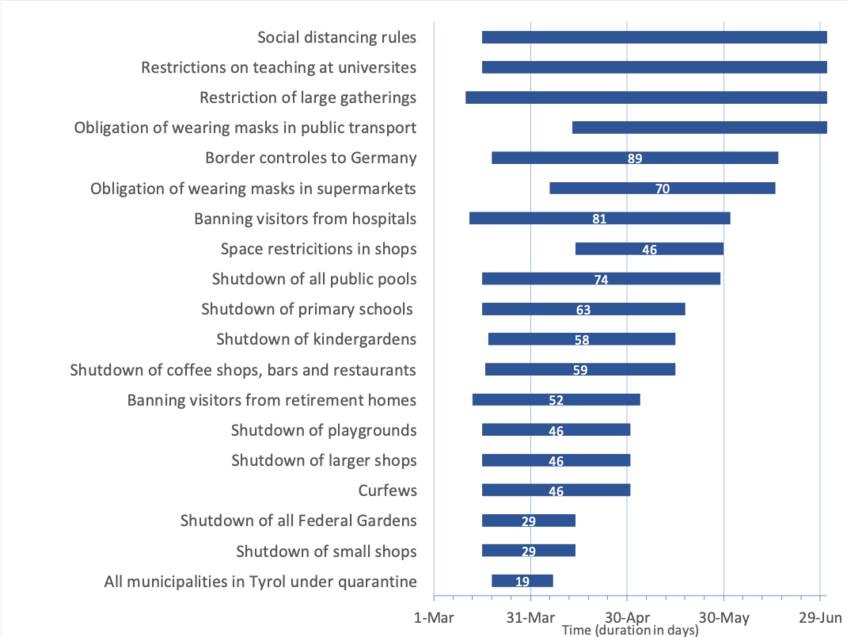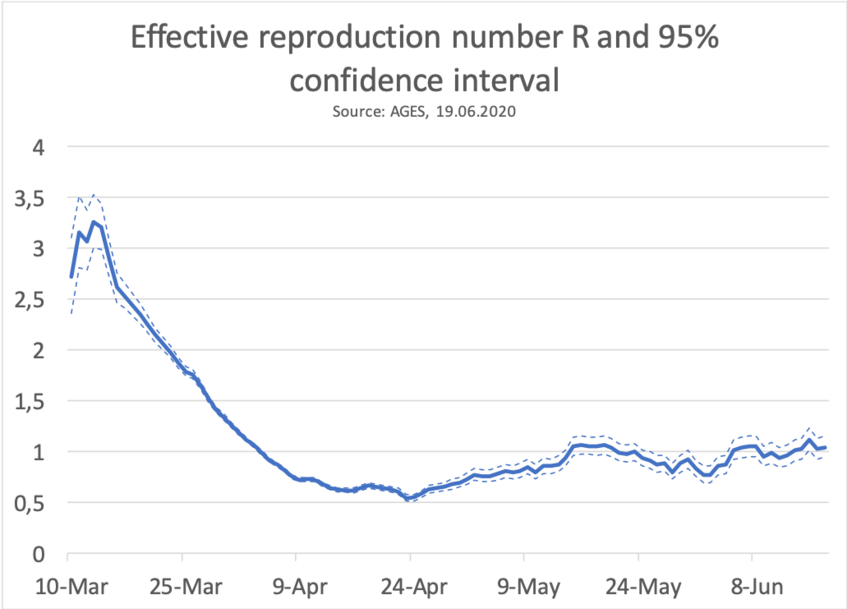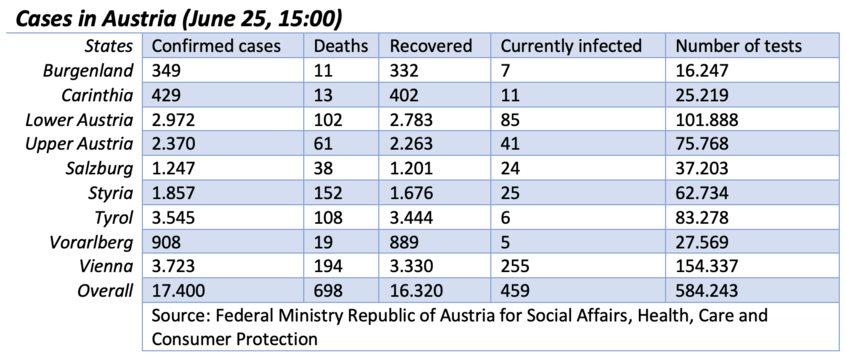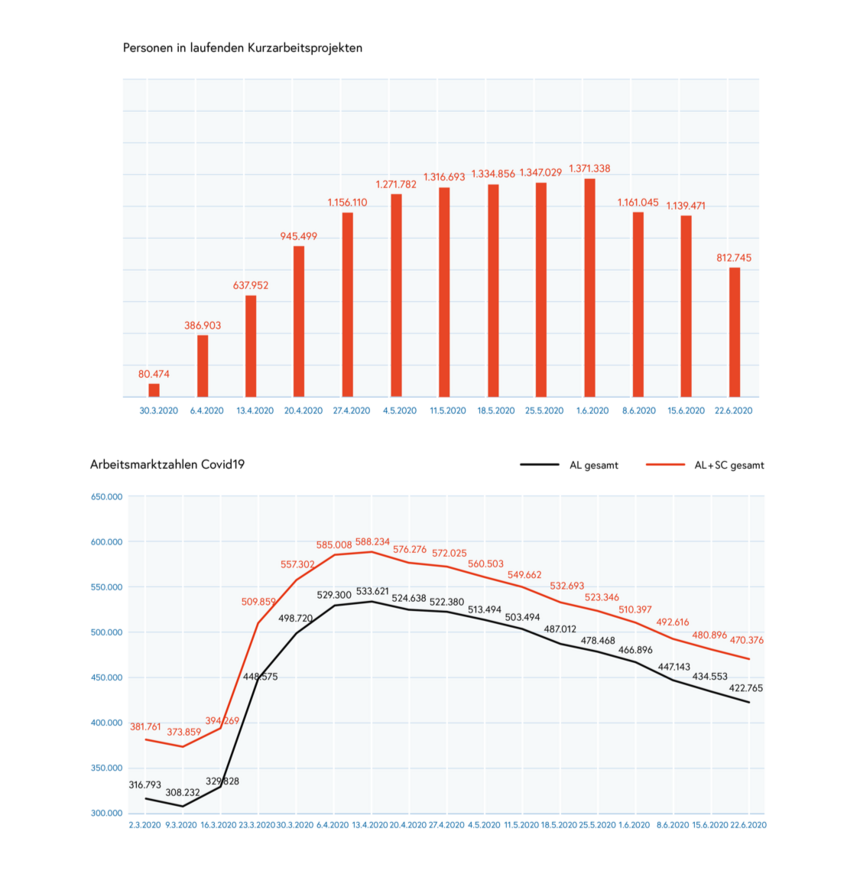26.06.2020
Chronology of the Corona Crisis in Austria - Part 2: From the first easing of measures towards restoring normality
- Since mid-April, Austria had gradually eased its measures to contain the coronavirus pandemic. As a result, public life had increasingly been returning to normality. However, some preventive measures remained in place.
- Among the measures with the longest duration of validity are restrictions on large in-person gatherings, restrictions at universities, and social distancing measures.
- After a sharp decline in infections in April and May, the number of confirmed cases had remained at a low level since the beginning of June and the effective reproduction number (R) had fluctuated around 1 since then. Since the early outbreak in Tyrol was contained, Vienna and Lower Austria have recorded the highest case numbers in comparison to other states (“Bundesländer”).
- Due to the easing of measures, economic life recovered, yet the economic impact of the crisis remained visible.
While the corona pandemic is still on the rise worldwide, the outbreak in Austria was contained comparatively quickly. From mid-April onwards, the measures were gradually eased. In many areas of public life, it has been possible to resume pre-pandemic lifestyles, although some restrictions remain in place. However, the return to accustomed lifestyles is also accompanied by the risk of a second wave, which is why the incidence of infection must be closely monitored.
In the first part of the Chronology of the Corona Crisis in Austria we have already described the general background, the early stages of the crisis, the way to the lockdown and the development of case numbers. In order to document the further developments of the corona crisis in Austria, the second part of our chronology deals with the easing of measures, the return to normality in public life and the further dynamics of infections.
April: First easing of measures after Easter and a change of strategy
After the peak of the epidemiological curve in terms of confirmed new infections had already been reached on 26 March (see the first part of the corona chronology), the Federal Government announced the first easing of measures on 6 April. In accordance with the stagewise plan for the gradual opening of shops after Easter, small shops (up to 400m²) as well as hardware stores and garden centres were able to reopen on 14 April. At the same time, the obligation to wear masks was extended to public transport and all shops that had not been previously affected. This meant that April was not only marked by the easing of measures, but also by a change in strategy, which withdrew measures to reduce contacts, while attempting to reduce the risk of infection by wearing masks and maintaining a minimum distance.
In addition, further steps to ease measures were taken in April: For instance, after a lasting public debate it was decided to reopen the Federal Parks. Moreover, the general quarantine in Tyrol was lifted on 7 April, although St. Anton, Paznauntal and Sölden remained isolated until 23 April. Tyrol had previously been identified as a centre of the pandemic and since 18 March all Tyrolean communities had been under quarantine.
The legally controversial initial curfews based on the lockdown regulation from March remained in force until the end of April. In practice, however, the restrictions had de facto already been eased when smaller shops were opened.

Figure 1: Chronology of events
May: Withdrawal of measures and the emergence of controversial public debates
In the light of the continuing decline of confirmed infection numbers, a further easing of measures was implemented in May. The regulation of 30 April laid down a new legal framework for the period from 1 May to 30 June. On 1 May followed the reopening of shopping centres, hairdressers and shops with over 400 m² of retail space. In addition, playgrounds were allowed to open in many places, although no respective nationwide regulation was adopted. On that day, the 600th death attributed to a COVID-19 infection was reported in Austria - the number of newly reported deaths has since fallen sharply. [1] Finally, on 4 May, following a recommendation by the Ministry of Health, the bans on visits to nursing homes were eased, and it became possible to receive visits under restrictions such as wearing masks.
This period was also characterised by the emergence of controversial public debates. On 13 May, for example, a public controversy arose over the visit of Chancellor Sebastian Kurz to Kleinwalsertal. In this context, the validity of the rules of social distancing and event bans were widely discussed. Furthermore, following protests by artists, the cultural and event sector, which had been badly hit by the Corona crisis, was subject of ongoing debates on the cultural policy of the federal government during the Corona crisis. As a consequence, State Secretary for Culture, Ulrike Lunacek, resigned on 15 May .
Further steps to easen measures followed: On 15 May the first pubs, coffee houses and restaurants opened under restrictions concerning the maximum number of visitors and the obligation to wear masks. Moreover, Minister of Education Heinz Faßmann already announced a phased plan for reopening schools starting on 25 April. Initially, face-to-face teaching resumed on 4 May exclusively for final year students (Matura, final year of secondary school). In addition, on the same day numerous kindergartens and childcare facilities in Vienna reopened, while in the other states they remained closed until 15 and 18 May, respectively. In March and April, however, kindergartens had never strictly been closed, as only partial restrictions were imposed, and a decree issued by the Ministry of Social Affairs merely contained a recommendation that kindergarten operators should close their facilities if possible.
Furthermore, the nationwide opening of elementary schools, new secondary schools (neue Mittelschulen), high schools’ (AHS) lower cycles and special schools followed on 18 May. The opening was constrained by social distancing rules and the obligation to wear masks in school buildings.
Following the entry into force of §5 of the easing regulation of 27 May, public swimming-pools were reopened on 29 May. However, as with the other measures repealed so far, "special preventive measures to prevent the spread of COVID-19" were introduced, such as wearing masks indoors and restrictive distance rules. Furthermore, the restriction on a minimum retail space per customer was lifted on 30 May.
Overall, many of the most drastic measures were thus gradually lifted in May. The controversial legal basis of some measures, such as the curfews, has been the subject of repeated discussions since then. Nevertheless, some measures remained in force, such as the distance rules, restrictions on teaching at universities, bans on large in-person gatherings, the obligation to wear masks and border controls (see Figure 2).

Figure 2: Period of various measures being in force
June: Further steps towards restoring normality
In June, most of the remaining measures were taken back or eased, leading to a growing normalisation of public life. The general practice of banning visits in hospitals was eased after 81 days of restrictions following a press release by the Ministry of Health. Since then, it has been possible to receive a maximum of one visitor, while the obligation to wear masks remained. In order to allow funerals and weddings, events with up to 100 participants were permitted again from 29 May onwards, whereas the compulsory wearing of masks in closed rooms remained in force. [2] Two days later, high schools’ (AHS) upper cycle students were able to resume on-site learning.
The last easing before the publication of this blog post was implemented on 15 June after a decision to amend the COVID-19 easing regulation. The obligation to wear masks was largely abolished, although it continues to apply in public transport, in the health sector and in shops where the minimum distance between customer and staff cannot be maintained. Furthermore, social distancing rules still apply for contacts with people outside their household (1m) and restrictions on teaching at universities remain in place. Since 4 June the borders to Hungary, the Czech Republic and Slovakia can be crossed without travel restrictions. Finally, on 16 June, after 89 days, travel restrictions and border controls with Germany and a number of other European countries were lifted.
Dynamics of infections
In view of the easing of measures, the dynamics of new infections and the emergence of new regional clusters need to be closely monitored. The effective reproduction number (R) is relevant for the assessment of pandemic developments (see Figure 3). R indicates the average number of people infected by an infected person [3] After a sharp drop in April, the figure rose slightly in May and June. Since then, the effective reproduction number has fluctuated around 1. Observing the further development of the effective reproduction number will be of great importance to assess the risk of a second pandemic wave.

Figure 3: Effective reproduction number
In general, local and regional clusters play an important role in this pandemic. In Austria a regionally uneven distribution of confirmed cases of infection can be observed. Tyrol, which was considered a hotspot at the beginning of the corona crisis, recently showed only 6 reported active COVID-19 cases (see Table 1). In contrast, according to data from the Ministry of Health, Vienna (255) and Lower Austria (85) reported the highest number of cases of infection as of 25 June. Thus, more than 74% of active cases of COVID-19 in Austria were found in these two densely populated states. The recent increase in the effective reproduction number in Austria can mainly be explained by the developments in Vienna and Lower Austria.

Table 1: Infection figures by states
Revitalization of the economic life
Since the easing of measures starting after Easter, economic activity has picked up again (see also the blog post on the consumer climate). However, on June 1, the Ministry of Labor reported the highest number of people registered for short-time work: 1,371,338. The number has been declining since then (see Figure 4). A downward trend can also be observed when looking at unemployment numbers, which had drastically increased in March. However, the pre-crisis level on the labour market is still far from being reached.

Figure 4: Short-time work and unemployment (source: www.bmafj.gv.at/Services/News/Aktuelle-Arbeitsmarktzahlen.html)
Conclusion
Since mid-April, many of the measures to contain COVID-19 have gradually been lifted. In May, in particular, numerous measures were removed; at the same time, political controversy sparked. Further steps towards normalisation were taken in June. Some measures, however, have remained in place, including restrictions on large in-person gatherings, the ban on on-site teaching at universities and social distancing rules. The increasing normalisation of public life makes it necessary to closely monitor infection rates in order to detect new outbreaks in time and take preventive measures if necessary. Although the effective reproduction number increased slightly during the easing of measures, it stabilised at a value of around 1 with some fluctuations. The regional focus of the corona pandemic shifted over time: While Tyrol was initially considered a crisis hot spot, Vienna and Lower Austria recently became the most affected states, albeit at a low level overall. The easing of measures was accompanied by an increasing economic revitalization. Short-time work and unemployment fell, but are currently still far above pre-crisis levels. So while the health risk has been reduced to a lower level, some of the economic consequences persist. However, as a second outbreak may occur at any time due to the logic of exponential spread of the coronavirus, it is necessary to closely monitor upcoming developments.
Markus Pollak works as student assistant at the Institute for Economic Sociology at the University of Vienna on the Austrian Corona Panel Project. He is studying political science for his Master's degree.
Nikolaus Kowarz works as student assistant at the Institute of Governance at the University of Vienna and is studying Political Science for his Master's degree.
Julia Partheymüller works as Senior Scientist at the Vienna Center for Electoral Research (VieCER) at the University of Vienna and is a member of the project team of the Austrian National Election Study (AUTNES). She received her doctorate in Social Sciences from the University of Mannheim and studied Political Science at the Free University of Berlin and the University of Hamburg.
Fußnoten
[1] All data on confirmed infections, deaths and growth rates in this article refers to the official data and the calculation method of the Austrian Ministry of Health as well as to the official dashboard COVID 19: https://info.gesundheitsministerium.at/ The figures may therefore differ from those of other sources. e.g. COVID-19 Dashboard by the Center for Systems Science and Engineering (CSSE) at Johns Hopkins University (JHU): https://coronavirus.jhu.edu/map.html
[2] Further easing of measures is to follow on 1 July (up to 250 people indoors, 500 people outdoors) and 1 August (up to 500 people indoors, 750 people outdoors).
[3] If the value is above 1, it means that there is a net increase in confirmed COVID-19 infections in Austria. Here you can find a more detailed description of the effective reproduction number: www.zeit.de/wissen/gesundheit/2020-04/coronavirus-deutschland-reproduktionszahl-infektionen
Related Blog Posts
Chronology
- February - March 2020: Blog 51 (EN) - Chronology of the Corona Crisis in Austria - Part 1: Background, the way to the lockdown, the acute phase and economic consequences
- July - September 2020: Blog 79 (EN) - Chronology of the Corona Crisis in Austria - Part 3: A calm summer and the beginning of the second wave
- October 2020 - January 2021: Blog 100 (EN) - Chronology of the Corona Crisis in Austria - Part 4: Lockdowns, mass testing and the launch of the vaccination campaign
- February 2021 - May 2021: Blog 112 (EN) - Chronology of the Corona Crisis in Austria - Part 5: Third Wave, Regional Lockdowns and the Vaccination Campaign
- June - November 2021: Blog 135 (EN) - Chronology of the Corona Crisis in Austria - Part 6: A "summer like it used to be", the way to the fourth wave, another lockdown and a vaccine mandate
English Summaries
- COVID-19 affects us all — unequally. Lessons from Austria
- From Acute Crisis to Long-Term Coping?
- The Coronation of Austria: Part 3
- The Coronation of Austria, Part 4
- The Coronation of Austria, Part 5: Time for a syndemic perspective?
- The Coronation of Austria: Part 6
